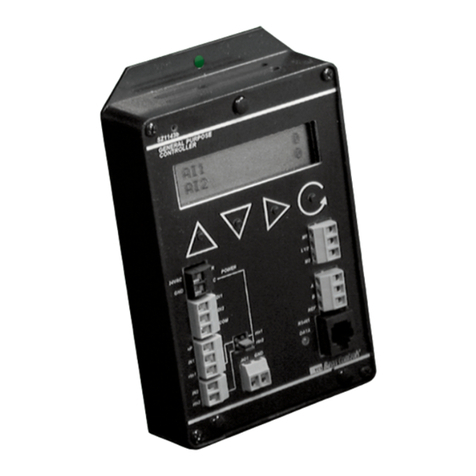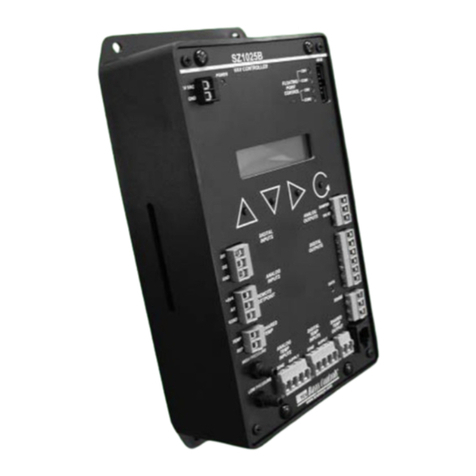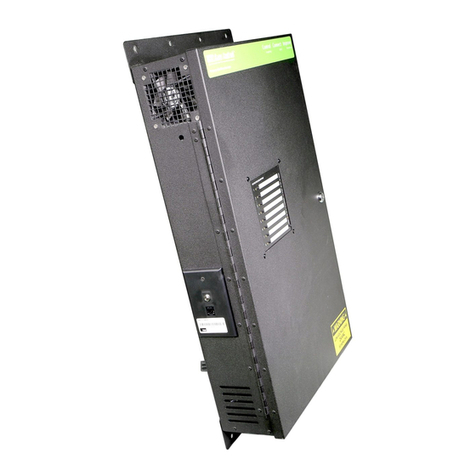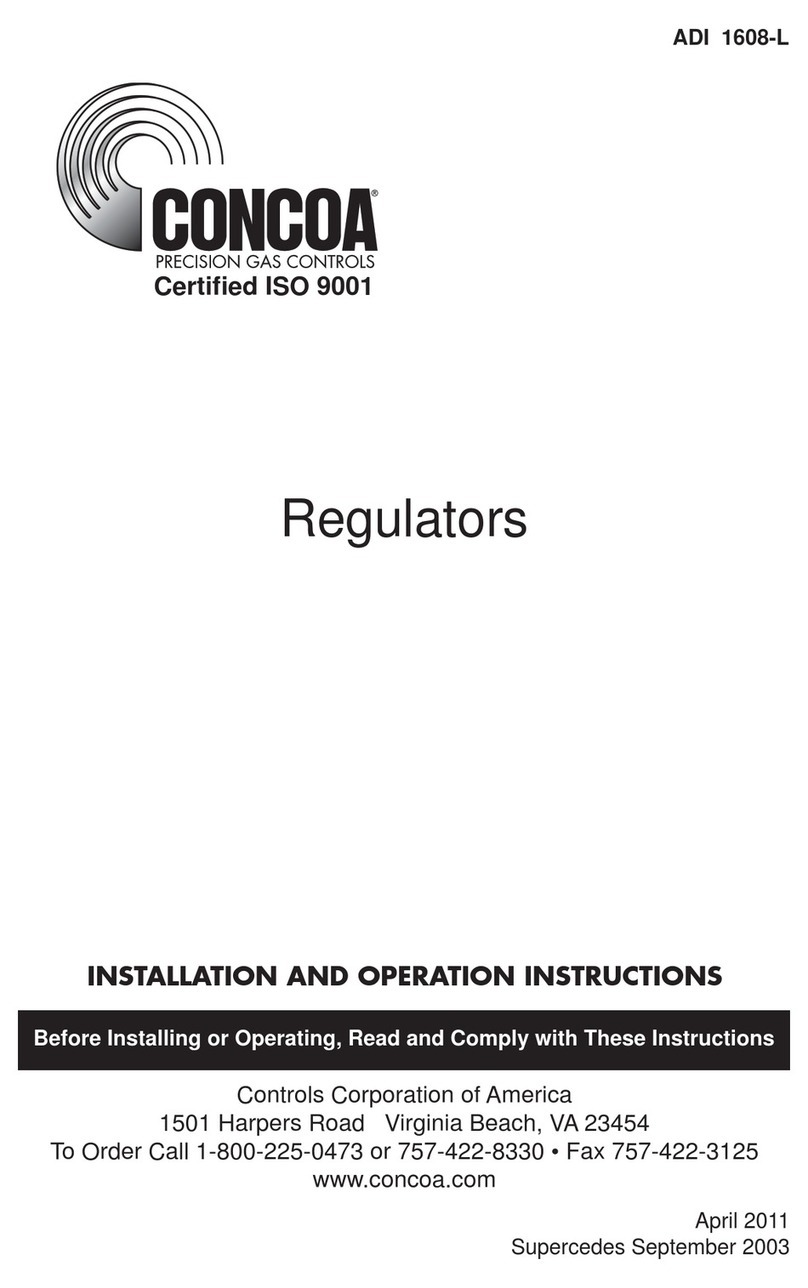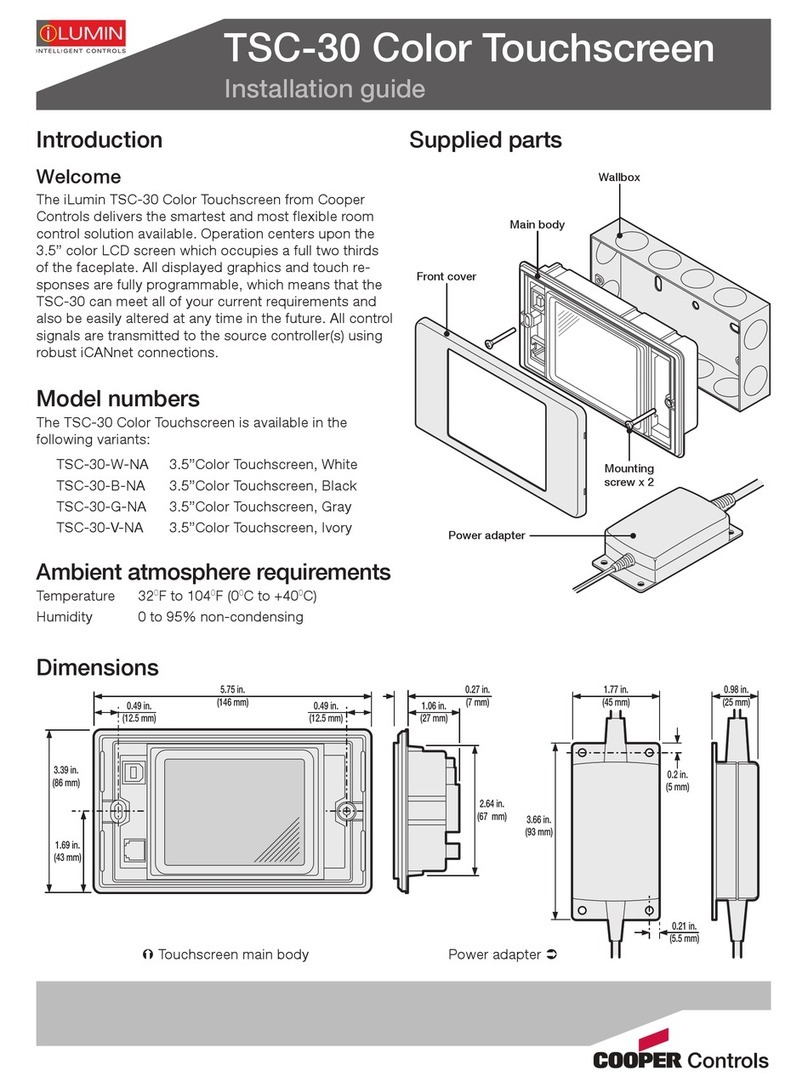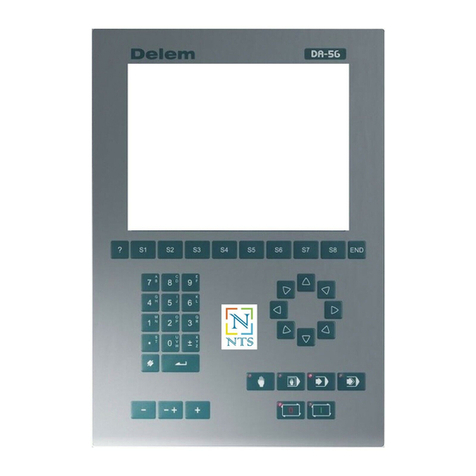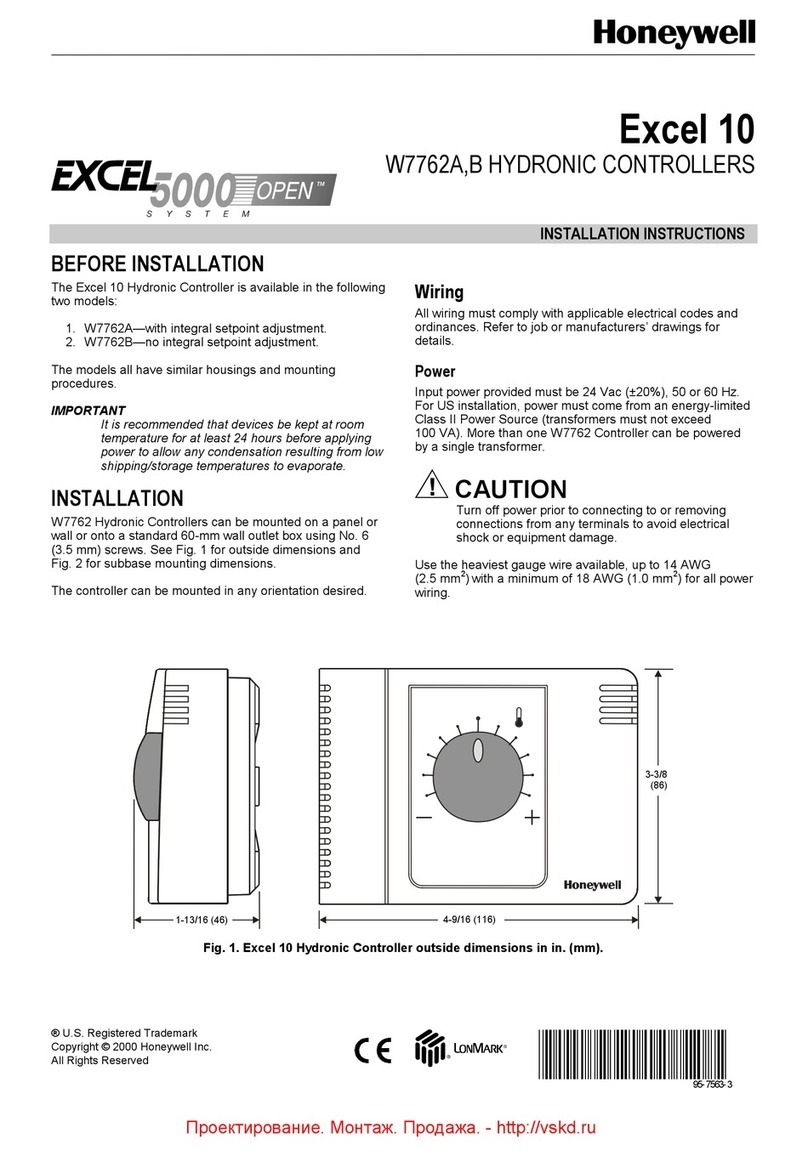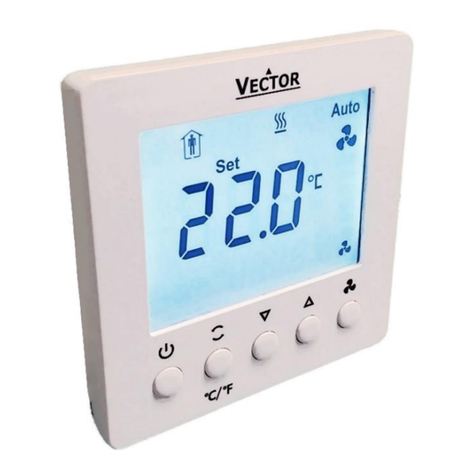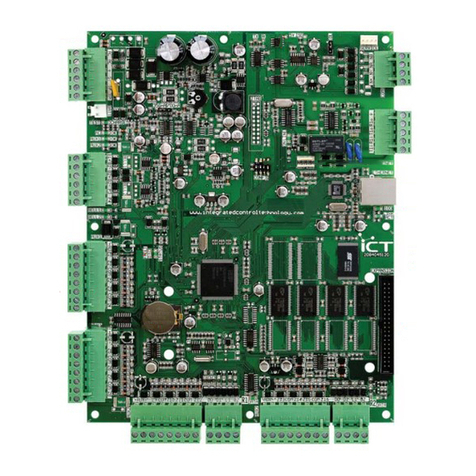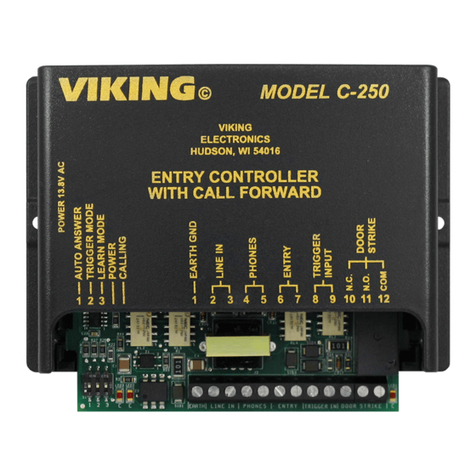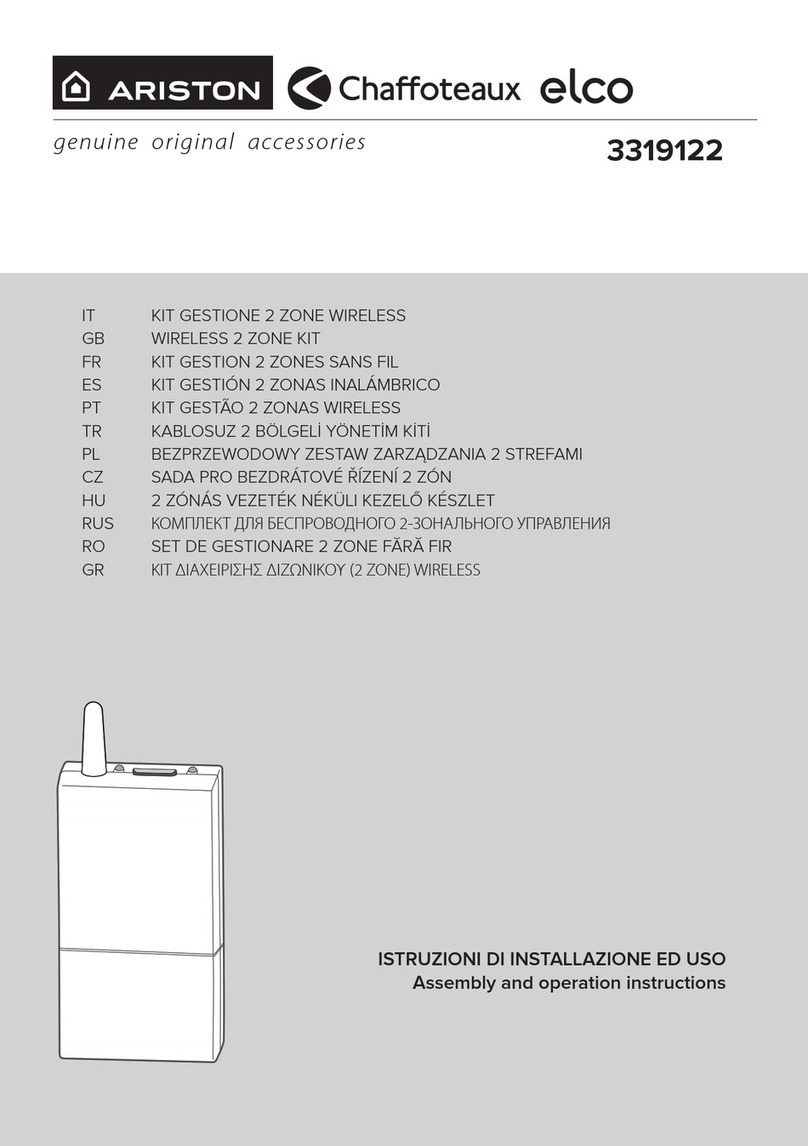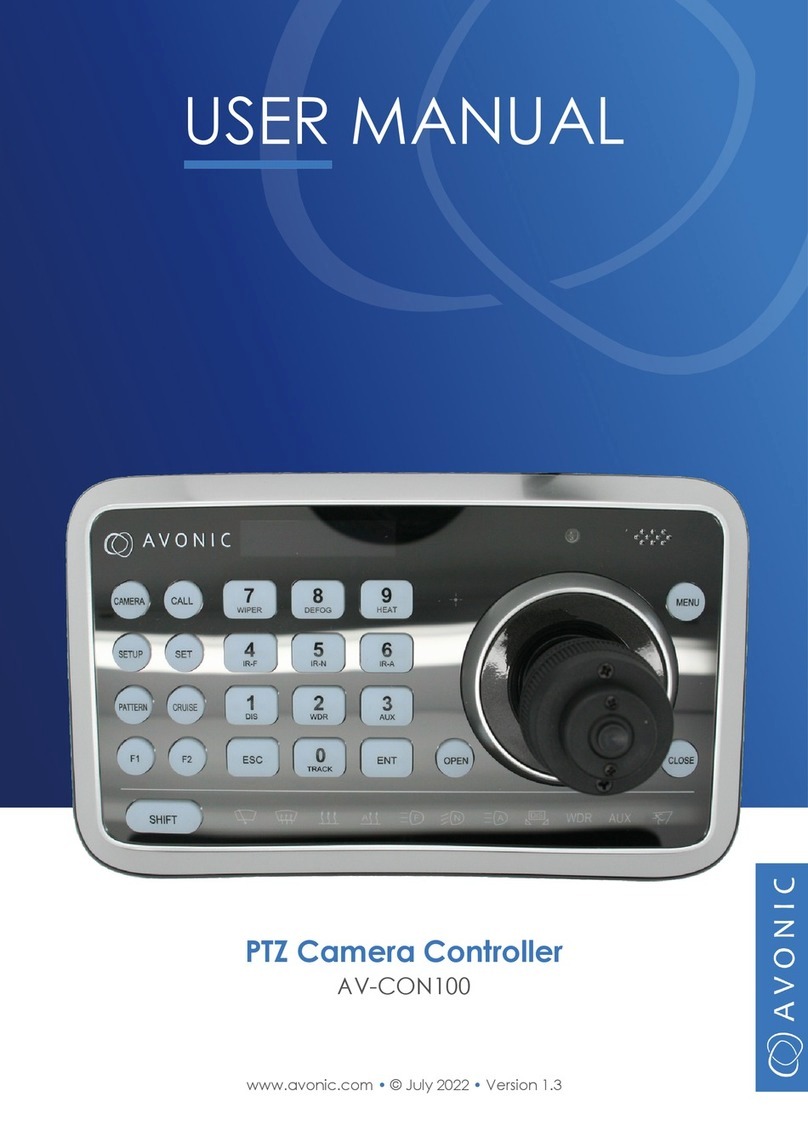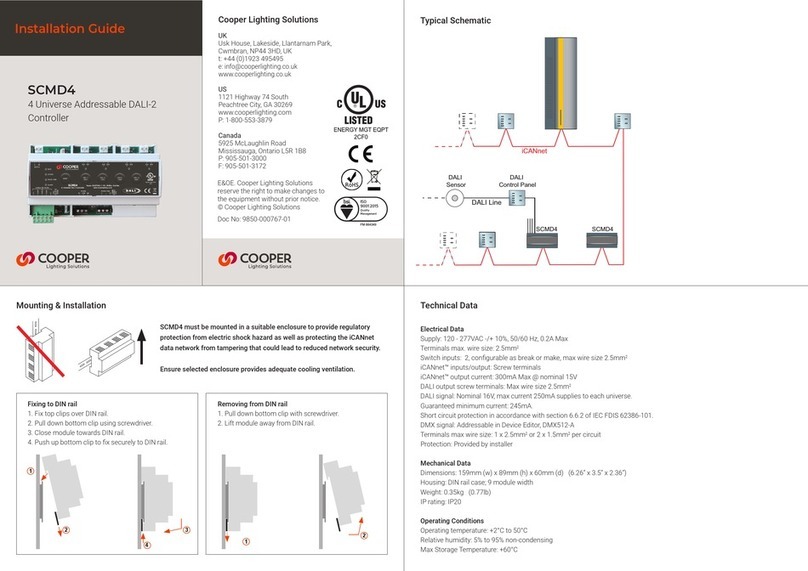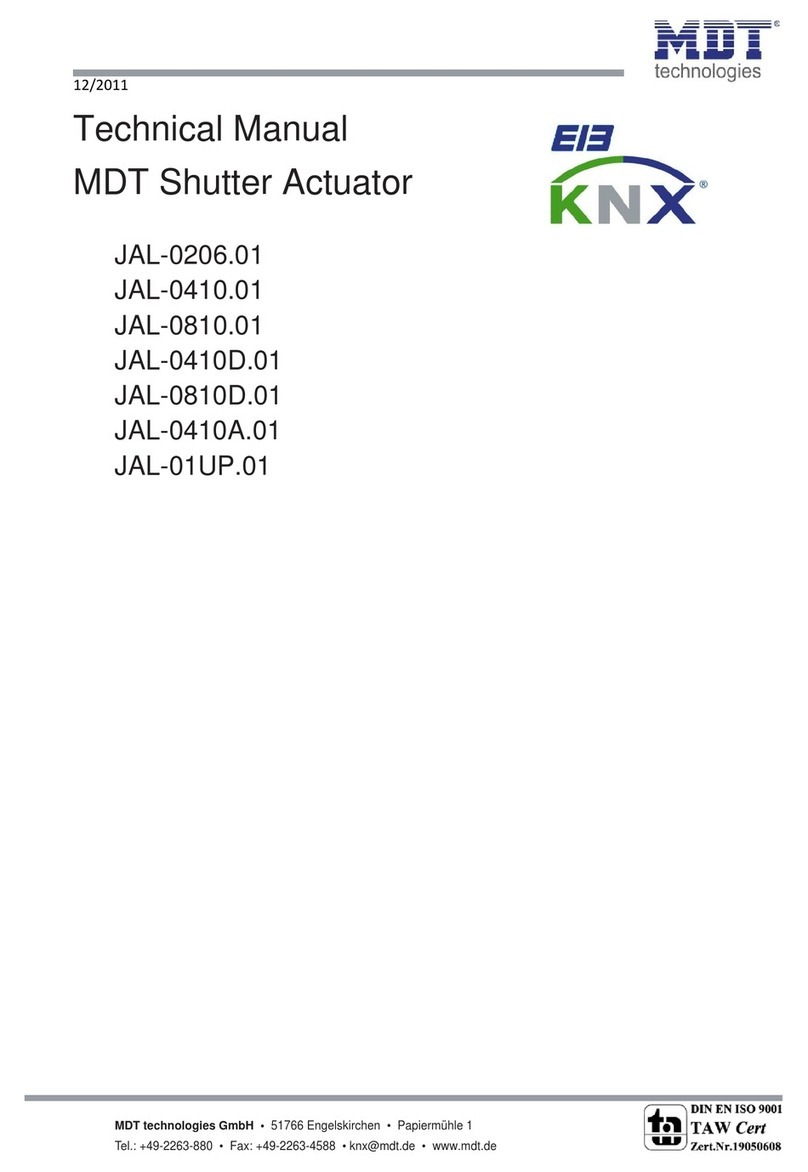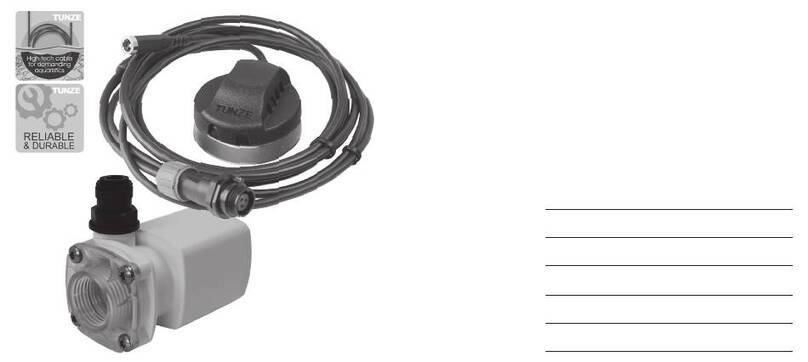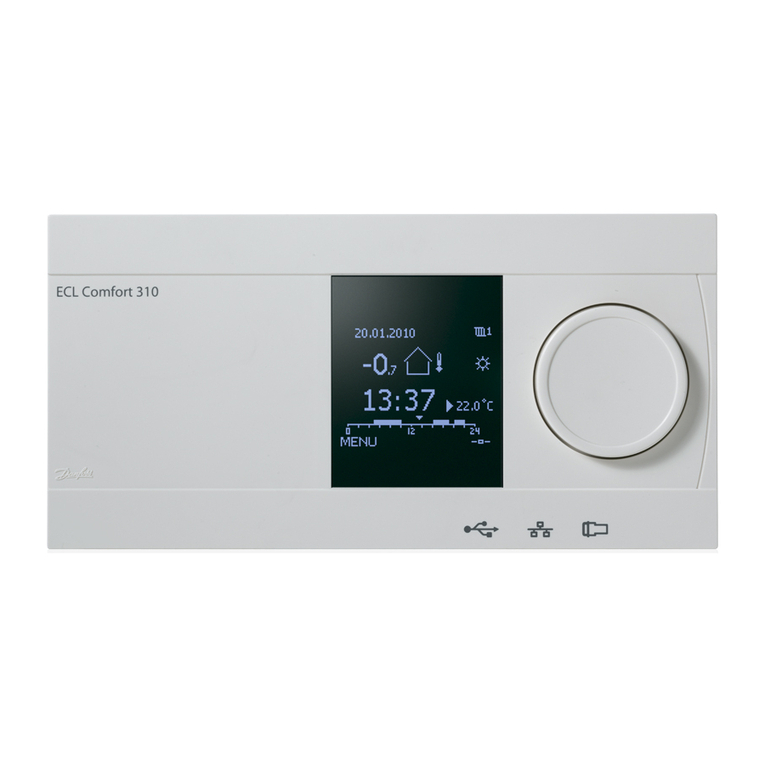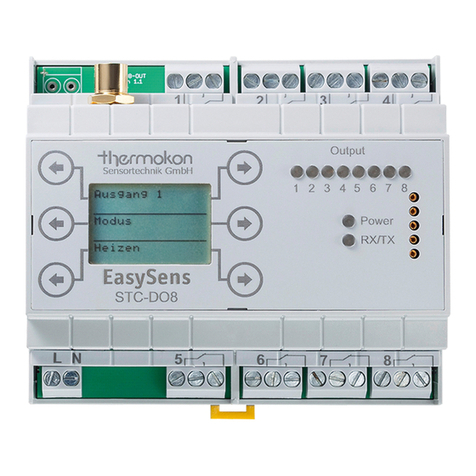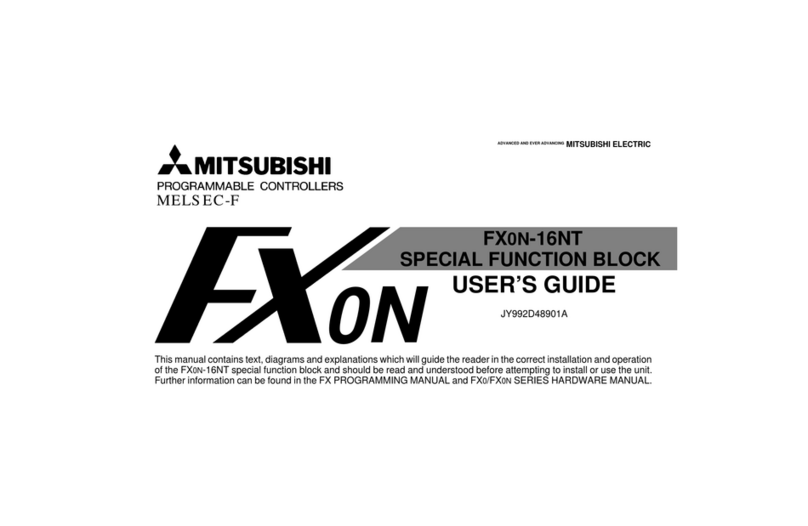TCS Basys Controls SZ2165 User manual

R
2800 LAURA LANE • MIDDLETON, WI 53562 • (800) 288-9383 • FAX (608) 836-9044 • www.tcsbasys.com
1
SZ2165
Boiler Controller
Product Manual
Description
The SZ2165 is a microprocessor based boiler controller. It is
designed for use on multi-stage boiler applications and includes
chiller support and control.
Features
• Stand-alone or network operation
• 365-day time clock with two holiday schedules, automatic leap
year and daylight saving correction
• No backup battery required for control parameters, schedule or
clock
• Hot water supply and return water temperature inputs
• Mixed water temperature input
• Chilled water supply and return temperature input
• Two digital outputs for chillers
• One digital output for alarm
• Outdoor air temperature input
• Outdoor air reset control
• Two digital inputs for pump status
• External time clock input
• Six digital outputs for boilers and boiler pumps
• Adjustable offsets and differentials on digital outputs
• Lead/Lag sequencing (rotation) of up to four boilers
• Two modulating analog outputs for valves and VFD
• LEDs for monitoring status
• Automatic rotation of pumps
• Alarm output
• Selectable normally open or normally closed relay outputs
Contents
Description ........................................... 1
Features ............................................. 1
Mounting............................................. 1
Wiring ............................................... 2
Setup ............................................... 3
Programming ......................................... 3
Sequence of Operations................................. 8
Checkout & Troubleshooting ............................. 8
LED Description ....................................... 9
Mounting
The SZ2165 is designed for mounting using four #10 sheet metal
screws. Prior to mounting, the jumpers should be placed. (See setup
instructions.) If the unit will be stand-alone, all programming should
be completed before installation. If the unit will be wired for communi-
cations, a unique address should be programmed into the unit. (See
programming instructions.)

R
2800 LAURA LANE • MIDDLETON, WI 53562 • (800) 288-9383 • FAX (608) 836-9044 • www.tcsbasys.com
2
Wiring
The SZ2165 terminal designations are shown below.
REMOTE SENSOR WIRING
The SZ2165 accepts six 1000 Ω two-wire platinum sensors. Consult
the TS Series Temperature Sensor submittal datasheet for a com-
plete listing of packaging and application styles. When using TCS
Basys Controls three-wire sensors, use the black and red leads, and
either clip or twist off the white lead. The wiring length should not
exceed 250 feet.
1
Black
Red
Black
Red
Black
Red
Black
Red
Black
Red
Black
Red
MIXING VALVE
+ -
A
B
AO1
GND
DI1
DI2
POWER
GND
GND
GND
AO2
24
VAC
GND
DI4
DI3
DI5
SZ2165
BOILER CONTROLLER
ANALOG
OUTPUTS
DIGITAL
INPUTS
PUMP
BOILER PUMP1
BOILER PUMP2
OVERRIDE
BOILER/
CHILLER
CHILLER PUMP
NO1
COM
COM
COM
COM
COM
COM
B
NO2
NO3
A
NO9
NO8
NO7
NO6
NO5
COM
NO4
TEMPERATURE INPUTS
HOT WATER
SUPPLY RETURN
CHILLED WATER
SUPPLY RETURN OUTDOOR
MIXED
WATER
S U P E R T R O L
TM
KBPS
4.8
9.6
19.2
BOILER4
BOILER3
BOILER2
BOILER1
ALARM
CHILLER2
CHILLER1/
ENABLE
BOILER PUMP1
BOILER PUMP2
DIGITAL
OUTPUTS
ALARM
CHILLER2
CHILLER1/ENA
BOILER PUMP1
BOILER PUMP2
BOILER1
BOILER3
BOILER2
BOILER4
POWER
OVERRIDE
OCC SERVICE DATA
+P
AI1
PRESSURE
ANALOG
INPUTS
T
1
T
1
T
2
T
2
T
3
T
3
T
4
T
4
T
5
T
5
T
6
T
6
+
-
+ +
+
XMTR
4
4
REF
2-wire, 4 to 20 mA transmitter.Sensor input
wiring 18 AWG, twisted, shielded pair.
7
Dry contact. Must not be powered.
4
Sensor input wiring 18 AWG, twisted, shielded pair.
3
For communication wiring, use twisted, shielded 22
AWG. Must be run separately.
1
24 VAC transformer. See powering instructions.
2
External relay. 24 VAC Coil
5
4 to 20 mA output. 600 ohm max. Do not power
actuator with power from the controller. The
controllers are half-wave rectified, whereby the
power ground is common with the signal ground.
6
REF
Add 500 ohm
resistor (included in bag) to
convert 0/4 to 20mA to, 0/2 to 10 VDC.
8
3 3 3 3 3 3
R
R
R
R
R
R
R
R
5
R
2
5
5
5
5
5
5
5
5
6
6
PA
VA
7
4
4
4
2
8
8
POWERING THE SZ2165
The SZ2165 is powered from 24 VAC +/- 20 %. If wiring for com-
munications, dedicated power must be used to power the SZ2165.
Several S-series controllers may be powered from the same trans-
former, provided that the transformer has enough power.
Caution: Do not connect to 120VAC. When multiple TCS/Basys
Controls devices are using a single transformer, the polar-
ity of the power wiring must be maintained because all
TCS devices are half-wave rectified and have common
return paths.

R
2800 LAURA LANE • MIDDLETON, WI 53562 • (800) 288-9383 • FAX (608) 836-9044 • www.tcsbasys.com
3
Setup
BAUD RATE SELECTION
The SZ2165 must be programmed
using a PC and TCS Basys Controls
software. A communication baud
rate must be set by placing one
jumper in the area shown. This
baud rate must be the same for all
devices.
For a 4.8K baud rate.
For a 9.6K baud rate.
For a 19.2K baud rate.
Programming
The SZ2165 must be programmed with a PC. A jack on the face
allows local access for programming. If you plan to program the con-
troller while it is on a network, prior to putting the controller on the
network, a unique address must be set in the controller by accessing
it through the port on the front.
For more information on programming using a PC and the
TCS Insight software, consult your TCS software manuals.
CONTROLLER ADDRESS
The factory default
address for an SZ2165 is
165 . On the "Network>
Poll" tab, right click on
the desired controller and
select "Change Address
from the menu that appears. Next, select the desired address from
the use the drop-down menu and hit ENTER. Finally, click "Yes" in
the Change Controller Address window that appears.
INTERNAL TIME CLOCK
On the "Schedules>
Date and Time" tab, you
can see and modify the
controller’s time (military
time), day of the week,
date and year. Click on
"Read" if you would like to see the current time, day of week and
date in the controller. Click on "To PC Time" read these parameters
from your computer instead and automatically program them into the
SZ2165. Finally you can click on "Write" to send the updated time,
day of week, and date to the controller.
EVENT SCHEDULING
On the "Schedules>
Schedules" tab there
are two occupied time
periods per day, and thus
two time schedules (A
and B). Let us say that
the occupied time for
a particular day is from
8:00AM to 12:00PM and
from 1:00PM to 5:00PM.
In the “A” schedule you
could enter 8:00 to 12:00,
and in the “B” schedule
you could enter 13:00 to
17:00. You can reverse
the “A” and “B” sched-
ules also. You can also
enter 8:00 to 17:00 for the “A” schedule and 0:00 to 0:00 for the “B”
schedule. 0:00 (12:00AM)starts the day, and 24:00 (12:00AM) ends
the day. Note: occupied times that span midnight have to be coordi-
nated using two days’ time schedules.
NOTE: The start of an occupied period is delayed by the
power-on delay value.
HOLIDAY 1 / HOLIDAY 2
On the "Schedules>
Holiday" tabs the holiday
schedules set which days
in a year will use Holiday
1 & Holiday 2 schedules
as defined. Each holiday
consists of a month
and date, as well as the
number of days that the
holiday will be in effect.
MONITORING
The "Monitoring" tab
displays the current tem-
peratures and the status
of all inputs and outputs.
These values are auto-
matically read when
accessing this tab initially
and are automatically
refreshed periodically
while viewing the tab. By
right clicking on a particu-
lar point, you can view
a live graph of that point
over time.
Black
Red
Black
Red
Black
Red
Black
Red
Black
Red
Black
Red
MIXING VALVE
-
A
B
R
AO
1
GND
DI
1
DI
2
POWER
GND
GND
GND
AO
2
24
VAC
GND
DI
4
DI
3
DI5
SZ2165
BOILER CONTROLLER
ANALOG
OUTPUTS
DIGITAL
INPUTS
PUMP
BOILER PUMP1
BOILER PUMP2
OVERRIDE
BOILER/
CHILLER
CHILLER PUMP
NO1
COM
COM
COM
COM
COM
COM
B
NO2
NO3
A
NO9
NO8
NO7
NO6
NO5
COM
NO4
TEMPERATURE INPUTS
HOT WATER
SUPPLY RETURN
CHILLED WATER
SUPPLY RETURN OUTDOOR
MIXED
WATER
U P E R T R O L
TM
KBPS
4.8
9.6
19.2
BOILER4
BOILER3
BOILER2
BOILER1
ALARM
CHILLER2
CHILLER1/
ENABLE
BOILER PUMP1
BOILER PUMP2
DIGITAL
OUTPUTS
ALARM
CHILLER2
CHILLER1/ENA
BOILER PUMP1
BOILER PUMP2
BOILER1
BOILER3
BOILER2
BOILER4
POWER
OVERRIDE
OCC SERVICE DATA
+P
AI
1
PRESSURE
ANALOG
INPUTS
T
1
T
1
T
2
T
2
T
3
T
3
T
4
T
4
T
5
T
5
T
6
T
6
-
+
PA
+
VA
+
XMTR
REF
-wire, 4 to 20 mA transmitter.Sensor input
wiring 18 AWG, twisted, shielded pair.
Dry contact. Must not be powered.
Sensor input wiring 18 AWG, twisted, shielded pair.
For communication wiring, use twisted, shielded 18
AWG. Must be run separately.
1
24 VAC transformer. See powering instructions.
External relay. 24 VAC Coil
4 to 20 mA output. 600 ohm max. Do not power
actuator with power from the controller. The controllers
are half-wave rectified, whereby the power ground is
common with the signal ground.
REF
Add 500O resistor (included in bag) to convert
0/4 to 20mA to, 0/2 to 10 VDC.

R
2800 LAURA LANE • MIDDLETON, WI 53562 • (800) 288-9383 • FAX (608) 836-9044 • www.tcsbasys.com
4
DIGITAL INPUTS
On the "Programming> Digital Inputs" tab select whether you want
DI1, DI2, DI3, DI4 or DI5 to be “Local” or “Remote”. Local means that
the controller uses its own control program when looking at these
inputs. Remote means that the controller will only recognize input
changes originating from a PC or other communication device.
DI1 can be used for “Boiler Pump 1 Proving” or just “Monitoring”.
If Boiler Pump 1 Proving is selected, the controller will turn on the
Boiler Pump 1 and then wait 30 seconds to make sure the Pump is
on (DI1 is shorted). This can be accomplished with a flow switch, cur-
rent switch or some other device. Any time Boiler Pump 1 is on but
DI1 is not shorted, “Heating” will be shut down. To restart heating,
you must short DI1 to GND.
DI2 can be used for Boiler Pump 2 Proving or Monitoring. If Boiler
Pump 2 Proving is selected, the controller will turn on Boiler Pump
2 and then wait 30 seconds to make sure the Pump is on (DI2 is
closed). This can be accomplished with a flow switch, current switch
or some other device. Any time Boiler Pump 2 is on but DI2 is not
closed, Heating will be shut down. To restart heating, you must short
DI2 to GND.
DI3 can be used for Monitor, External Override or External Time
Clock. If External Override is selected, the controller will use its built-
in time clock and schedule to determine whether to be occupied or
unoccupied, and will also be occupied as long as DI3 is On (closed).
If External Time Clock is chosen, the controller will not use its built
in time clock and schedule to determine whether to be occupied or
unoccupied. The controller will be occupied as long as DI3 is On
(closed) and unoccupied as long as DI3 is Off (Open). NOTE: the
start of an occupied period is delayed by the power-on
delay value.
DI4 is available for monitoring. Select “Boiler/Chiller Alarm” to moni-
tor alarm conditions such as High Temperature, Low Water Level,
etc. (Note: no action will be taken by the controller for this alarm. It
is only being monitored.) Select “Monitoring” to detect more general
conditions.
If monitoring is selected, there is an option to enable Domestic
Hot Water (DHW) Override. When Domestic Hot Water Override is
enabled and DI4 is applied, the boiler pumps will turn off and the
boiler stages will maintain the high limit setpoint regardless of the
reset schedule. This override will operate for a 1 hour maximum,
after which the boiler pump will turn back on and the unit will function
normally.
DI5 can be used for Chiller Pump Proving or Monitoring. If Chiller
Pump Proving is selected, the controller will turn on the Chiller Pump
and then wait 30 seconds to make sure the Pump is on (DI5 is
closed). This can be accomplished with a flow switch, current switch
or some other device. Any time the Chiller Pump 1 is on but DI5 is
not shorted, Cooling will be shut down. To restart cooling, you must
short DI5 to GND.
REMOTE OVERRIDE
Using DI3 you can override the controller (put it in Occupied Mode).
First, using hte drop-down menu select "External Override" as the
function for DI3. Next using the Source drop-down menu select
"Remote" (this means the values come via software). Finally, select
"ON" from the Override drop-down menu and then click "Write
Page". This will bring the controller to occupied mode permanently.
NOTE: You must change the Source back to Local in
order for the controller to go back into normal operation.
BOILER AND PUMP RELAYS
The Boiler Pump and Boiler Stage Relay Outputs can operate in
N.O. (Normally Open) or in N.C. (Normally Closed) mode. The
default is N.O., whereby when the pump or stage output is On, the
relay closes. NOTE: if using N.C. mode, you will need to
have pilot relays to turn on the pumps and stages, and
the LED indication on the SZ2165 will be reversed, i.e.
when the pump or stage is On, the LED is Off and when
the pump or stage is Off, the LED is On. N.C. mode will
have the pumps and stages fail On.
BOILER PUMPS
Choose whether or not to enable Boiler Pump Operation. If not
selected, the boiler pump outputs will not function.
The boiler pumps can be rotated automatically based on their
run times. Choose whether to enable the Automatic Boiler Pump
Rotation, and if so, enter the time in hours that one pump must run
before switching to the other pump.
LEAD BOILER PUMP
Choose whether Boiler Pump 1 or Boiler Pump 2 will be used as
the Lead boiler pump. The other one will be treated as the backup
pump. This selection can be used to manually alternate the boiler
pumps.
ENABLE PUMP LUBE
Choose whether you want to enable the enable pump lube function.
The Enable Pump Lube function turns on the pump every Sunday
morning at 4:00AM for the allotted purge time that is programmed in
for that particular pump.
SERVICE/ALARM STATUS
The Service Status field on the "Monitoring" tab shows various sta-
tus messages depending on which alarms have been setup - OK,
CWS_Hi/Lo (chilled water supply), HWS_Hi/Lo (hot water supply),
BLP1 (bolier pump 1 prove), BLP2 (boier pup 2 prove), DI4 (bolier/
chiller alarm), DI5 (chiler pump prove).

R
2800 LAURA LANE • MIDDLETON, WI 53562 • (800) 288-9383 • FAX (608) 836-9044 • www.tcsbasys.com
5
SETPOINTS
Enter Occupied and Unoccupied tem-
perature setpoints for Hot Water Supply,
Chilled Water Supply, Mixed Water,
Hot Water Return and Analog Input
(Pressure). Also enter a High and Low
Limit for each setpoint, if desired.
RESET
The analog outputs and digital output
stages on the SZ2165 can be setup
to use a reset function. This is done
by placing a check in the appropriate
Enable Reset box. When using the reset
function, the Hot Water Supply, Chilled
Water Supply, Mixed Water, Hot Water
Return and/or Analog Input (Pressure)
are the Primary temperature inputs and
the Outdoor Air Temperature is the Reset
input.
You need to enter a primary occupied
and unoccupied setpoint in the Setpoints
section above. These setpoints will be
adjusted up and down based on the out-
door air temperature, the reset setpoint
and the reset factor. The analog output(s)
and digital output(s) will be controlled
using these calculated setpoint(s).
You need to enter a reset setpoint. A
comparison between the outdoor air
temperature and this setting will be used
in determining the calculated setpoint for
each respective input.
You need to enter a reset ratio factor. This
is the number of units that the respective
input setpoint is raised when the outdoor
air temperature falls below the reset set-
point by 1 unit, or the number of units that
the respective input setpoint is lowered
when the outdoor air temperature rises
above the reset setpoint by 1 unit.
example - A hot water valve is controlled using an outdoor air reset
schedule. If the outdoor air temperature is 0°F, the hot water tem-
perature is controlled at 200°F. If the outdoor air temperature is 60°F,
the hot water temperature is controlled at 80°F.
The hot water supply temperature setpoint is set to 140.
(200 + 80) / 2 = 140
The reset setpoint for the hot water supply temperature is set to 30.
(0 + 60) / 2 = 30
The reset factor for the hot water supply temperature is set to 2.
(200 - 80) / (60 - 0) = 120 / 60 = 2
OUTPUTS
For the Pump Outputs you need to enter an Occupied and
Unoccupied Outdoor Air Temperature Setpoint.
For a Cooling output (Chiller Stage(s)) the relay energizes when the
input equals the Chilled Water Setpoint + Offset + Differential and de-
energizes when the input falls to the Chilled Water Setpoint + Offset.
For a Heating output (Boiler Stages) the relay energizes when the
input equals the Hot Water Setpoint - Offset - Differential and de-
energizes when the input rises to the Hot Water Setpoint - Offset.
Enter the Offset and Differential values here.
DELAYS
Enter the Minimum ON and Minimum OFF times (in seconds) here
for all of the output stages, as well as a Purge Time and Minimum
ON and OFF times (in minutes) for the Loop pump. A Purge Time
is the amount of time (in minutes) that the pump will continue to run
after all of the stages are off.
BOILER CONTROL
The boiler can be controlled by either Hot Water Supply Temperature
or by Gauge Pressure. Choose the signal that the boiler will be con-
trolled from. Note - all outputs (Analog and Digital) will be controlled
based on this decision.
MIXED WATER
If using a valve to control mixed water temperature, place a check in
the “Enable Mixed Water Control" checkbox. When you do this, AO1
will be used to control the Mixed Water Temperature independent of
Hot Water or Chilled Water control.

R
2800 LAURA LANE • MIDDLETON, WI 53562 • (800) 288-9383 • FAX (608) 836-9044 • www.tcsbasys.com
6
PROPORTIONAL + INTEGRAL
The Proportional + Integral function implements a way to anticipate
the need for heating using the boiler stages. This function works in
conjunction with the programmed offsets and differentials. Select
whether to enable the Proportional + Integral function. By default,
this function is disabled when the “Integral Setting” is zero. When
enabled, the integral setting can be from 1 to 255. Larger numbers
speed up the response, while smaller numbers slow down the
response.
TEMPERATURE INPUT CALIBRATION
The six tempera-
ture inputs are fac-
tory calibrated. However,
depending on the appli-
cation (long wire runs,
etc.), there may need
to be a field adjustment
done to these readings.
The “Adjusted Reading”
is the reading that the
SZ2165 actually uses for
control. The Offset Value
is the number of degrees
that the actual input temperature has been adjusted. For example:
You measure the hot water supply temperature and it reads 71°.
The SZ2165 reading is 72° and the Hot Water Supply Temperature
already has an offset of -2.0°. All you need to do is change the offset
value to -3.0° and you’re done. The SZ2165 will now read 71°.
The Hot Water Supply and Return inputs are scaled 40 to 240°F (4.4
to 115.6°C). The Chilled Water Supply and Return inputs are scaled
0 to 100°F (-17.8 to 37.8°C). The Mixed Water input is scaled 20 to
220°F (-6.7 to 104.4°C). The Outdoor input is scaled -40 to 160°F
(-40 to 71.1°C). These ranges are fixed and cannot be changed.
HOT/CHILLED WATER TEMPERATURE ALARMS
Choose whether to enable High and Low Water Temperature Alarms.
If enabled, you will need to enter a High and Low Limit for each
desired Water Temp Alarm.
AI PRESSURE RANGE
The boiler can be controlled by either Hot Water Supply Temperature
or by Gauge Pressure. If controlled by gauge pressure, choose the
range of the pressure transducer as being either 0 to 100 psi, 0 to
500 psi, or custom. If custom select 0 to 100 psi and fill in the AI
pressure range high limit.
BOILER STAGE ROTATION
Choose whether to enable Boiler Stage Rotation. Boiler rotation is
cyclical, i.e. before rotation, Boiler 1 is the first stage, Boiler 2 is the
second stage, Boiler 3 is the third stage and Boiler 4 is the fourth
stage. After one rotation, Boiler 2 is the first stage, Boiler 3 is the
second stage, Boiler 4 is the third stage and Boiler 1 is the forth
stage. If using Boiler Stage Rotation, select the number of weeks
between rotations and select the time of day that you would like the
rotation to occur, or enable rotation based on runtime, then enter the
time between change (5 hours to 1000 hours).
BOILER STAGES
Select the number of Boiler Stages that will be used in the Boiler
Stage Rotation. If using 4 stages, you can select to “Swap” stages
1 & 2 with stages 3 & 4. This is useful if using two boilers with two
stages each.
BOILER STAGE ORDERING
Select the boiler stage ordering. The term Boiler refers to the physi-
cal connections to the SZ2165. The term Stage refers to the order
in which the boiler stages cycle on and off. The factory default is to
have Boiler 1 be Stage 1, Boiler 2 be Stage 2, Boiler 3 be Stage 3
and Boiler 4 be Stage 4. Note: the boiler stages can be placed in any
order whether using boiler rotation or not. If boiler rotation is used,
this is the starting order, after which the boiler stages will be rotated
in order.
CHILLER 1 / PUMP ENABLE
Chiller Stage 1 can either be the first of two stages of chiller control,
or it can be treated like a pump (or enable) function. If selected as
a pump (or enable) function, outdoor air temperature will determine
when this output energizes. If selected as chiller stage 1, chilled
water temperature will determine when this output energizes.
CHILLER STAGE ROTATION
If Chiller Stage 1 was not selected to be a pump in the above step,
choose whether to enable Chiller Stage Rotation. If using Chiller
Stage Rotation, select the number of weeks between rotations and
select the time of day which you would like the rotation to occur.
Note: the chiller stages can be placed in any order whether using
chiller rotation or not. Chiller Stage 1 must not be enabled as a
Pump. If chiller rotation is used, this is the starting order, after which
the chiller stages will be alternated.
CHILLER STAGE ORDERING
Select the chiller stage ordering. The term Chiller refers to the physi-
cal connections to the SZ2165. The term Stage refers to the order
in which the chiller stages cycle on and off. The factory default is to
have Chiller 1 be Stage 1 and Chiller 2 be Stage 2.
ANALOG OUTPUT 1
Analog output one on the SZ2165 can be used to control Hot Water
Supply Temperature, Mixed Water Temperature or control based on
Pressure.
During the occupied time, an analog output modulates to maintain a
heating or cooling temperature setpoint. During the unoccupied time
you will need to choose whether the analog output will modulate,
remain at 20mA, or remain at (0 or 4)mA.
A proportional band (throttling range), whether you want the ana-
log output to modulate from 4 to 20mA or 0 to 20mA, and direct or
reverse action must also be programmed.
For control without "Integral" and "Derivative", enter 0 for both. The
proportional band is 0 to 100%, while the integral and derivative val-
ues are numbers from 0 to 255. The default PID values for AOI are

R
2800 LAURA LANE • MIDDLETON, WI 53562 • (800) 288-9383 • FAX (608) 836-9044 • www.tcsbasys.com
7
P=4, I=25, D=200, PID Step=5, PID delay=2 and PID Error DB=0.
See the PID Control Factors section for more details.
ANALOG OUTPUT 2
Analog output two can be used to control a Heating Device (based
on Hot Water Supply Temperature), a Cooling Device (based on
Chilled Water Supply Temperature) or control based on Hot Water
eturn Temperature.
During the occupied time, an analog output modulates to maintain a
heating or cooling temperature setpoint. During the unoccupied time
you will need to choose whether the analog output will modulate,
remain at 20mA, or remain at (0 or 4)mA.
A proportional band (throttling range), whether you want the ana-
log output to modulate from 4 to 20mA or 0 to 20mA, and direct or
reverse action must also be programmed.
For control without "Integral" and "Derivative", enter 0 for both. The
proportional band is 0 to 100%, while the integral and derivative val-
ues are numbers from 0 to 255. The default PID values for AO2 are
P=4, I=25, D=200, PID Step=5, PID delay=2 and PID Error DB=0.
See the PID Control Factors section for more details.
PID CONTROL FACTORS
There are three main factors involved in PID control - the propor-
tional, the integral and the derivative factors. The proportional factor
dictates how much gain the input signal error should be given with
respect to the derivative and the integral error terms. A large integral
factor will cause the output to respond quickly to changes on the
input however the output could oscillate and overshoot the setpoint.
A large derivative factor will cause the output response to be slug-
gish and slow to change and the output will settle above the desired
set point. The derivative term is divided by the PID delay. The default
values programmed at the factory are a good point; however, those
values should be adjusted/tuned as needed for your particular instal-
lation to achieve the desired operation.
PID OPTIONS
The default values are Step Constant=1, PID delay=10 and PID Error
DB=0. The Step Constant determines how large of step the output
takes - the larger the number, the smaller the step size. The Step
Constant is typically 1, but should NEVER be 0 (doing so will cause
the system to stay at full output). The Delay parameter specifies how
quickly the output should evaluate error between the current output
and the desired output. The PID delay can be used to offset a slow
moving motor allowing the motor to catch up to its input signal before
the error term is reevaluated. The Error Deadband allows the system
to overlook error between the desired setpoint and the input signal to
help the system stabilize. The Error Deadband is typically 0. It is pre-
dominantly used in a situation where a small amount of error would
cause a large swing in the output or response (for example, CFM
output versus supply or input pressure).
DELAY ON POWER
After recovering from a
power loss, the controller
will wait this amount of
time before starting to
control. Different control-
lers in one building can
have different delays so
that all units don’t come on at the same time. Enter a delay time (in
seconds) that you want the Controller to use on power up.
DAYLIGHT SAVING TIME
Daylight Saving Time (DST) in the U.S. is currently from the 2nd
Sunday of March to the 1st Sunday of November. Products shipped
starting in 2007 with firmware version 1.5 or higher accommodate the
new DST schedule. Products shipped starting in 2008 with firmware
version 2.0 or higher accommodate the new DST schedule and have
the ability to be programmed to accommodate any future schedules
that may be used. Should the schedule change and you need to
customer program the DST start and end dates, simply enable the
"Daylight Saving Time" option within the software and enter the start-
ing month + week and the ending month + week.
COMMUNICATION FAILURE
If "Enable Comm. Loss Function" is selected, the SZ2165 will go
into occupied control mode if communications with it is lost and it will
stay in the mode until communications returns. The "Delay Before
Loss of Comm Function" value is the number of seconds the unit will
wait after communications are lost before engaging the Comm. Loss
Function. Be sure to set the Comm. Delay time to at least 60 sec-
onds as the QD2040 and QD2010 poll the local controller network
once per minute.
HOLIDAY VANISHING
Choose whether to enable the Holiday Vanishing Feature. If checked,
the SZ2165 will make the number of days for a holiday 0 after the
holiday is over. This will keep the holiday from occurring in subse-
quent years if it is not reprogrammed.
OVERRIDE STATUS
The "Time Allowed" field is the number of minutes from 0 to
255 (4 hr., 15 min.) which the controller will hold an unoccu-
pied system occupied, when its override button is pressed. You
can also enable "Occupied Override" which allows the over-
ride to work during occupied periods. In that case, the control-
ler would go from occupied to unoccupied when its override
button is pressed.
REMOTE OVERRIDE
In order to override
the controller (put it to
Occupied Mode), select
“ON” from the drop-down and then click on WRITE PAGE. This will
bring the controller to occupied mode for the amount of time set on
the previous screen in the “Time Allowed” box. If the override time
needs to be extended, make sure that "On" is selected and then
click WRITE PAGE. This will restart the override timer. To stop the
override, select “OFF” from the drop-down and then click on WRITE
PAGE.

R
2800 LAURA LANE • MIDDLETON, WI 53562 • (800) 288-9383 • FAX (608) 836-9044 • www.tcsbasys.com
8
Sequence of Operation
HOT WATER
SUPPLY TEMP
BOILER STAGE 4
BOILER STAGE 3
BOILER STAGE 2
BOILER STAGE 1
OFFSET
DIFFERENTIAL TYPICAL OF HEATING
140°F
PROPORTIONAL
BAND (PID)
MIXING
VALVE
OUTDOOR AIR
TEMPERATURE
CHILLER ENABLE /
HYSTERESIS
60°F
CHILLER STAGE 1
CHILLED WATER
SUPPLY TEMP
CHILLER STAGE 1
CHILLER STAGE 2
OFFSET
DIFFERENTIAL TYPICAL OF COOLING
45°F
PROPORTIONAL
BAND (PID)
MIXING
VALVE
BOILER PUMP 1
60°F
OUTDOOR AIR
TEMPERATURE
20°F
BOILER PUMP 2
HYSTERESIS
HYSTERESIS
Checkout & Troubleshooting
CHECKOUT
1. Be sure to check and verify all wiring before powering the
SZ2165.
2. Turn power on. The SZ2165 "Power" LED should light up. Then
the Service LED will blink for 15 seconds while the electronics
stabilize.
3. If the SZ2165 has not been pre-programmed, It should be pro-
grammed at this time.
4. Increase and decrease the Heat and Cool setpoints. This must be
done from a PC. Observe the operation of the relay stages and or
analog ouput(s).
5. Note that the operation of the SZ2165 will depend on how it is
programmed.
The SZ2165 is now ready for operation.
TROUBLESHOOTING
Power LED will not come on
Check for 24 VAC on terminals “24 VAC” and “GND”. The rest of
the trouble shooting must be done with a PC and the Revelation
Professional software.
No communications
Make sure baud rate selection jumper for the QD1010 and the
SZ2165 are the same, and that Revelation is configured for that
same baud rate. Address 248 will always work provided that the
SZ2165 is NOT connected to a network.
Inputs do not read correctly
The SZ2165 is calibrated at the factory. For the loop supply tem-
perature and other temperature readings make slight adjustments
(+/- 12% of the input span). on “Screen D” of the SZ2165 program-
ming screens. (See Temperature Input Calibration on page 6.)
Output operation is not correct
Check programmed parameters, in particular “Reverse” and “Direct”
acting selections and “Heat” or “Cool” selections for the analog out-
puts, and “Offset”and “Differential” selections and “Delay Times” for
the relay outputs. Check wiring.
A pump won't turn on
If a pump will not turn on when it should, DI1, DI2 or DI5 may be set
for a pump proving function. If a pump fails, DI1, DI2 or DI5 must be
momentarily shorted in order to restart the respective pump.
LED Description
Sixteen LEDs on the unit allow the occupant to view the current
operating status of the SZ2165.
POWER: This LED will be lit whenever the unit has power.
DIGITAL OUTPUTS: These LEDs will be lit when the corre-
sponding relay outputs are on. Relaly outputs include pumps, boiler
stages, chiller stages, etc.
OCC: This LED will be on whenever the unit is operating in the
occupied mode.
SERVICE: This LED will be on whenever the unit has a service
condition. This LED also blinks on powerup until the electronics sta-
bilize.
DATA: This LED will blink when the unit is being accessed by a
PC.
Rev: 0911
C3545_REV2
Table of contents
Other TCS Basys Controls Controllers manuals
